Clorinda Agonistes
Souls, Struggles, and Spin
Clorinda Agonistes
by Shobana Jeyasingh, music by Claudio Monteverdi and Kareem Roustom
Shobana Jeyasingh Dance and Sadler’s Wells at The Grange Festival, The Grange, Northington until 14th July, then on tour until 16th November
World Premiere. Part of Baroque Counterpoint
Review by Mark Aspen
Crusade is a word that must nowadays be used with great circumspection. Cultures have now become less polarised, but in 1591 when the Italian epic poet Torquato Tasso wrote his Gerusalemme liberata, he took an entirely different approach. A poem about the Siege of Jerusalem in 1099 and the First Crusade, it is highly romanticised and weaves in an imaginative mythology. The spin is doctored towards the European standpoint.
Choreographer Shobana Jeyasingh’s new work Clorinda Agonistes focusses in on one character of Tasso’s twenty canto poem, the Muslim maiden warrior Clorinda. It contrasts and compares the Clorinda of 1099 with women, Clorindas, in the Middle East in 2022. At a time when cultures are (trying to become) more integrated, this could be a polemic on religious identity or on feminism. It is neither. It is a balanced, inspired and powerfully gripping account and one that asks more questions than it answers.
Tasso’s Gerusalemme liberata became fruitful source material for almost every Baroque opera composer, most notably George Frideric Handel in his 1711 opera Rinaldo. His librettist Giacomo Rossi concentrated on cantos involving the aristocratic leaders of the Crusade. In contrast, Monteverdi’s 1624 operatic cantata, Il combattimento di Tancredi e Clorinda is based on mainly Canto XII of Tasso’s epic, involving the two warriors, the Christian Tancred (Tancredi) and the Muslim Clorinda. It is this piece that forms the basis of Act One of Clorinda Agonistes.
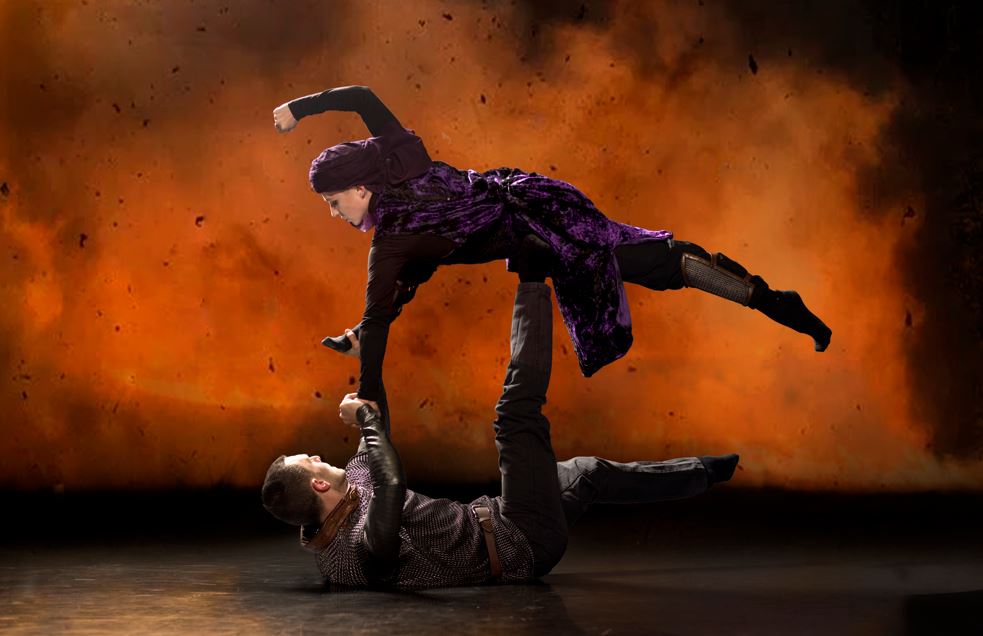
Very much the brainchild of eminent Indian choreographer Shobana Jeyasingh CBE, Clorinda Agonistes embraces her multi-cultural, crossover dance style in a multi-disciplinary work melding opera, contemporary dance and video art. It is her own conception, and she directs and choreographs this remarkable work, which forms the second half of Baroque Counterpoint, a double bill with New English Ballet Theatre, as The Grange Festival’s Dance@TheGrange 2022.
Richly matured colours of designer Merle Hensel’s reductionist set forms a backdrop to a quasi-realistic arc of steely columns, which transmute to trees or to concrete stanchions as the action proceeds. Her costume designs hint at chainmail or hijab, flak-jacket or abaya. Lee Curran lights the set with changing colour, flecks fall as smuts or shrapnel. Mist and smoke hides or reveals.
Revealed are the musicians as they assemble within the action. They are baroque strings, including chitarrone, led by musical director Robert Hollingworth on the harpsichord, which is featured in Monteverdi’s Il combattimento in the first act. The sextet play the exquisite score with an agility that befits the baroque. They reconfigure on stage for Act Two, which is composed by Syrian-American composer Kareem Roustom. Emmy-nominated composer Roustom crosses from the baroque to Arabic-inspired polyrhythmic music, with its drones and intoned singing and a dabkehfolk-dance, originating in the Levant.

It might be thought that the juxtaposition of baroque and Arabic music might be jarring, but far from it. The tonalities and counterpoint of the baroque typical of Monteverdi is seamlessly run across into the intoning and to polyrhythms. Monteverdi would probably have approved, as he was a great innovator. He was more or less the inventor, four hundred years ago of the stile concitato (agitated style), which included such new-fangled ideas as pizzicato and tremolo. Hollingworth and his musicians happily and skilfully make this subtle transmutation.
The transition during the time when the musicians are offstage is accomplished by a hauntingly hypnotic passage, Clorinda seeing heaven open to receive her, which is part of the soundscape of the versatile Parisian sound designer Fred de Faye. One is enfolded into the surround-sound of his musically mesmerising audio background that eventually resolves into white noise. It is highly atmospheric.
Il combattimento di Tancredi e Clorinda tells, as the name suggests, of the hand-to-hand combat between the two protagonists, both experienced and successful warriors. Just before dawn on the day of the battle, Clorinda has set the Christian’s siege tower on fire, but now she and Tancredi meet in gladiatorial close combat. Jemima Brown makes a fierce and spiky Clorinda, interpreting her in bold movements of controlled tension. Jonathan Goddard’s Tancredi is a determined and powerful presence, who dances with strength and agility. Their continuous duet of martial struggle is played out moves reminiscent of fencing thrusts, parries, and ripostes, or the ducks and weaves of the boxer, or the deft suri ashi footwork of judo. It is a spectacular dance exposition.
On stage with them, tenor Ed Lyon delivers Monteverdi’s libretto with power and passion, in the form of Torquato Tasso himself, who gets more and more sucked into the fervour of his own narrative until he becomes physically involved in the action. Lyon is a versatile operatic performer with a luxuriant velvety voice. His repertoire ranges from early baroque to Offenbach operettas, but here his acting skills are extended to include musical movement within the dance itself. Symbolically, Tasso’s direct involvement, and interventions, begs the question, who writes history?
Tancredi had already seen Clorinda and had fallen in love with her from afar, not knowing who she was. On the morning of the battle she had discovered that her mother was an Ethiopian princess, a Christian. When they meet in battle, Tancredi does not know the person behind the armour is a woman, let alone the woman who has so enchanted him. She will not state her name. When Tancredi mortally injures Clorinda, and removes her helmet, only then does he realise who she is. He baptises her so that she can convert to Christianity before she dies. She sees Heaven opening for her, “S’apre il ciel: io vado in pace” (Heaven opens: I go in peace).
In Jeyasingh’s Clorinda Agonistes, though, Clorinda does not in a sense die. Her spirit lives in the struggles of women in the Middle East today, depicted as four Clorindas.
The starting point for Kareem Roustom is, as with Monteverdi and many other composers, again Tasso’s poem Gerusalemme liberate. He has contextualised parts of the libretto, translating them into Arabic to express their meanings from a different viewpoint. The text, now in Arabic, is taken from Lyon on stage to the mezzo-soprano Dima Orsho singing in recording. Damasan-born Orsho is well-known for her contributions to world music both as a signer and a composer, and has studied opera at the Boston Conservatory. Her voice is absorbing in its ambience.
Roustom has also scored a poem written by the Baghdadi poet Al-Abiwardi just after the Siege of Jerusalem in 1099, in which Al-Abiwardi upbraids the powers that be in Baghdad at the time for not intervening when the Crusaders took Jerusalem. Dima Orsho sings with evocative emotion as the sentiments of the two poems are acted out in dance by Brown as an ensemble with three other dancers, Emily Thompson-Smith, Harriet Waghorn and Ellen Yilma. Their dance interpretation is emotionally expressive, but has sinew and veracity. The compelling narrative they create in dance is potent and gripping.

The dance quartet reimagines Clorinda suffering the tribulations of women in the 21st Century Middle East, not so much as four individuals, but as a manifestation of a collective individuality. Hensel’s set design becomes the canvas for Nick Hillel’s disturbing sepia video projections created with his cutting-edge video-installation, animation and documentary company, Yeast Culture. These create a sense of reality from the constantly changing images of unrest, destruction, war and chaos, which is the day to day existence of many in today’s world.
As the quartet, form, break up and reform in response to oppressive influences, waves of movement almost create a pattern, a vicious spiral of mayhem. A pushchair is overturned and mothers run clutching their babies. Sometimes they are commonly cooperative, sometimes aggressive.
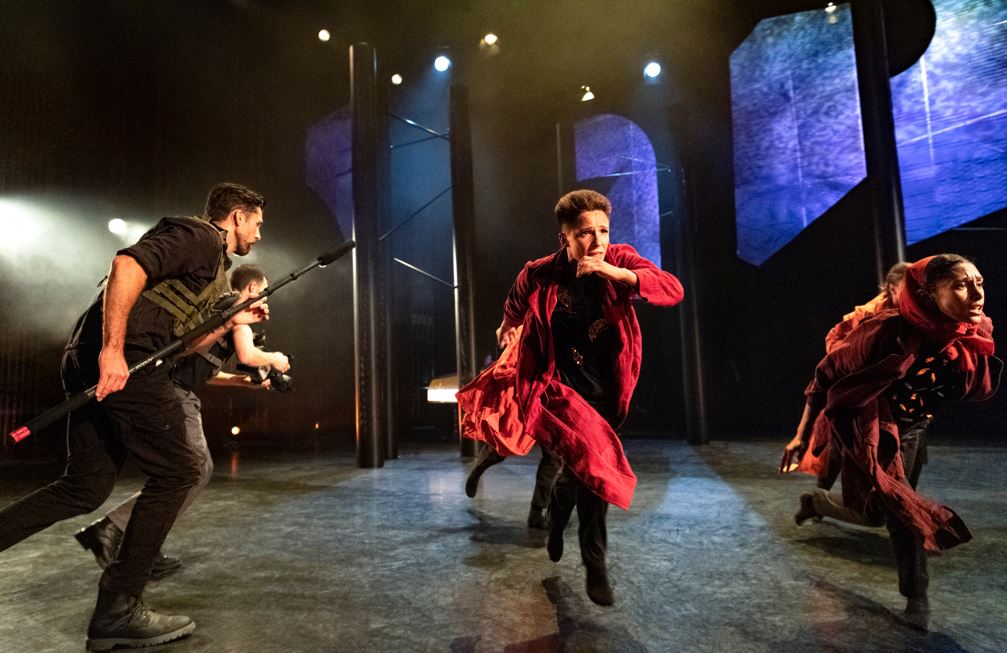
Jonathan Goddard reappears as a 21st Century Tancredi, a newsgathering cameraman, looking for the most sensational shots. His battle for souls is now a battle for scoops. Ed Lyon’s Tasso is now the accompanying boom-mic operator. His quest to influence is now a quest to record. What now is the spin?
Is it a case of plus ça change, plus c’est la même chose ? In what we now call the Middle East there have always been internecine or tribal wars on one hand and those between big Asian powers. This part of world has attracted European influence. In 1099 it was the (now unfashionable) pursuit of souls; in 2022 it is the (now unfashionable) pursuit of oil. Perhaps what has now changed is Clorinda, the personification of the role of women.
Clorinda Agonistes is an intense and thought provoking work, skilfully bringing together attitudes bridging many centuries. It is moreover a multifaceted and stimulating work of art. “East is east and west is west”, but here the twain do meet.
Mark Aspen, July 2022
Photography by Chris Nash and Foteini Christofilopoulou

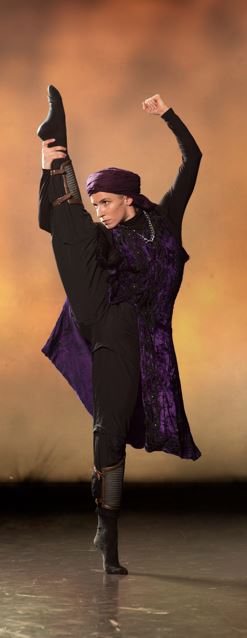

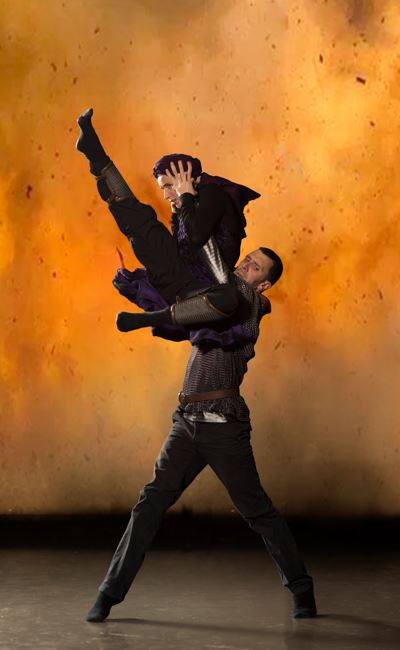
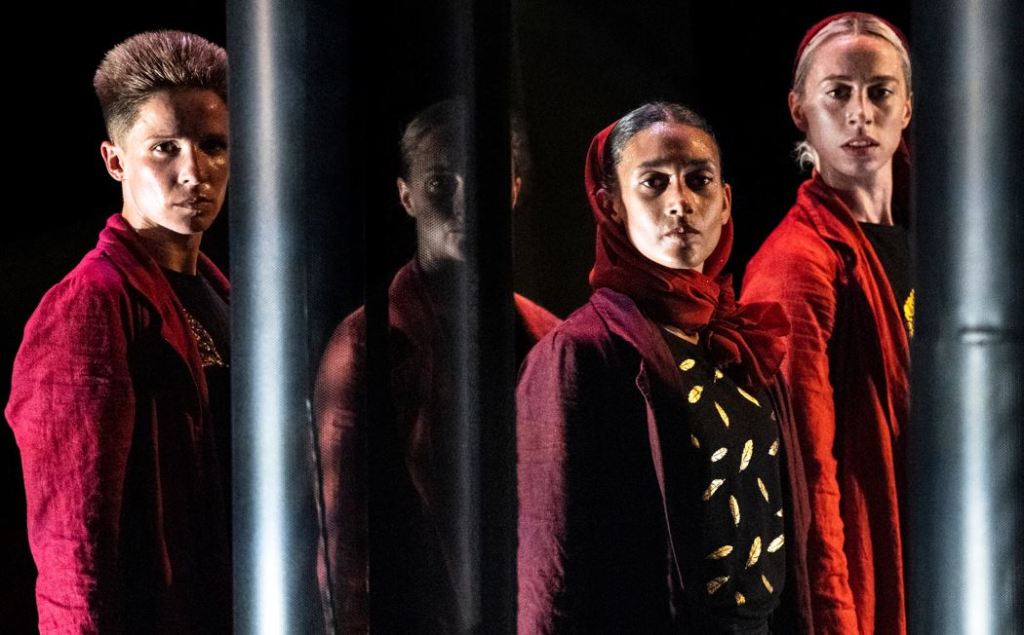
Trackbacks & Pingbacks